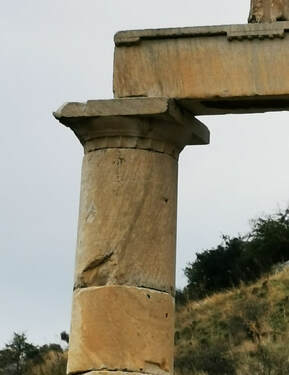
When ephesus tour guides start their walking tours of the ancient city of Ephesus, they start the tour from the Upper Gate of this amazing ancient city.
The first structures of attraction welcoming the visitors are the Prytaneion, Senate Hall. You will see on this post some detailed information about these sites of attraction. If you want to book a Private Tour of Ephesus includes this Amazing Attraction Please Click HERE.
For centuries The Artemis Cult shaped the religious and spiritual history of Ephesus city until the emergence of the Christianity as the official religion.
 Artemis of Ephesus discovered near Prytanaeion Artemis of Ephesus discovered near Prytanaeion
The transition to monotheism was not sudden but a process by which the old gods were replaced gradually.
The extend to which Artemis was revered can be discerned by the attributes granted to her by her followers. Such as The Founder, The Saviour, Exhaulted Mother of the Earth and Sublime Daughter of Zeus. There are however certain distinctions between the Artemis of Greek Mythology and the Artemis of Ephesus.  A Clay Jug shaped as Mother Goddess Deity Anatolian Civilisations Museum, Ankara A Clay Jug shaped as Mother Goddess Deity Anatolian Civilisations Museum, Ankara
In Ephesus, the Cult of Artemis was influenced by many of the Eastern Religions, and can be traced back to the concept of the Mother Goddess found all over Anatolia.
The merging, and integration of multiple divine attributes into the single figure of Artemis can be said to have paved the way for a gradual acclimatization to the concept of monotheism.  Sacred Ramp leading up to Prytaneion Sacred Ramp leading up to Prytaneion
The Prytaneion was where the city's political affairs were managed and was the symbol of the Greek City States' independence and sovereignty.
As an ancient version of the modern city hall it was the heart of the settlement and was the most important of the official structures.  Doric Column Capital from Prytaneion Ephesus Doric Column Capital from Prytaneion Ephesus
Here at the center of power the sacred fire burned continuously.
The Sacred Fire was the symbol of the City's Fortunes and was kept the flame at all times as the loss or extinction of the fire was considered a bad omen. Aside from its role as a symbol of the city the fire of Hestia also had a more practical function as it provided the fires of the citizens homes.
The official responsible for assuring the fire in temple remained alive was known as the Prytaeon who performed his duties in the name of Hestia, the Goddess of the Heart and the Family. Consequently the Prytaeon was amongst the highest administrative and religious posts in the city.  Artemis Statue at Ephesus Museum, Turkey Artemis Statue at Ephesus Museum, Turkey
However it was a Statue of Artemis, and not Hestia, that was erected in Ephesus as the protectress of the City.
The 2 World Famous statues of Artemis, now on display in the Ephesus Museum were unearth from the Prytaneion relatively unschated. The presence of Artemis in the Temple instead of the Goddess of the Hearth indicates the esteem in which this deity was held by the citizens of Ephesus. |
